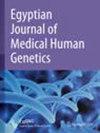蜂毒联合索拉非尼通过诱导细胞凋亡和自噬候选基因对 HepG2 细胞株的潜在抗癌作用
IF 1.2
Q4 GENETICS & HEREDITY
引用次数: 0
摘要
肝细胞癌(HCC)是一种严重威胁,也是全球癌症相关死亡的主要原因。索拉非尼(Sorf)是治疗 HCC 的有效一线疗法,但其耐药性非常普遍。许多天然化合物,特别是蜂毒(BV),据称在单独使用或与化疗联合使用时对癌症有很大的疗效。因此,本研究旨在探讨蜂毒单独使用和/或与索夫联合使用对 HepG2 肝癌细胞系的抗癌效果。通过实时定量 PCR(qPCR)和 Western 印迹检测 Bax、Bcl-2 和 Beclin-1 的 mRNA 和蛋白表达,研究 BV 和 Sorf 单药及 BV/Sorf 联合用药对 HepG2 细胞株的凋亡和自噬调节作用。我们的研究结果表明,BV 和 Sorf 无论是单独使用还是联合使用,都对 HepG2 细胞具有相当大的剂量依赖性抗增殖作用,其中联合疗法的影响最大。单一 BV 和 Sorf 治疗的 IC50 分别为 93.21 和 7.28 μg/ml,而联合治疗的 IC50 为 6.73 μg/ml BV + 6.73 μg/ml Sorf。此外,与 BV 或 Sorf 单独处理相比,BV/Sorf 处理后促凋亡基因 Bax 和自噬相关基因 Beclin-1 的 mRNA 表达均出现了显著上调,而抗凋亡基因 Bcl-2 mRNA 表达则出现了显著下调。这些 qPCR 结果在 Western 印迹中得到了进一步证实。这些研究结果表明,BV 可通过诱导细胞凋亡和自噬机制协同增强 Sorf 对 HepG2 细胞的抗癌作用。本文章由计算机程序翻译,如有差异,请以英文原文为准。
The potential anticancer effect of bee venom in combination with sorafenib against HepG2 cell lines via induction of apoptosis and autophagy candidate genes
Hepatocellular carcinoma (HCC) is a severe threat and a main reason for cancer-related deaths around the world. Drug resistance to sorafenib (Sorf), the effective HCC first-line therapy, is very common. A number of natural compounds, notably bee venom (BV), have been claimed to show a great impact against cancer when administered on its own or in conjunction with chemotherapy. Thus, this study aimed to investigate the anticancer effect of BV alone and/or combined with Sorf on HepG2 liver cancer cell lines. Both mRNA and protein expressions of Bax, Bcl-2 and Beclin-1 were investigated by quantitative real-time PCR (qPCR) and western blot respectively, to examine the apoptotic and autophagic regulatory effects of BV and Sorf single treatments plus BV/Sorf combination on HepG2 cell lines. Our findings showed that BV and Sorf had considerable dose-dependent anti-proliferative effects on HepG2 cells whether administered alone or in combination, with the greatest impact for the combined therapies. Single BV and Sorf treatments showed IC50 of 93.21 and 7.28 μg/ml respectively, while combined treatment showed IC50 of 6.73 μg/ml BV + 6.73 μg/ml Sorf. Moreover, both the pro-apoptotic gene Bax and the autophagy-related gene Beclin-1 showed significant up-regulation in their mRNA expression, while the anti-apoptotic Bcl-2 mRNA gene expression showed significant down-regulation after BV/Sorf treatment as compared to either BV or Sorf single treatment. These qPCR results were further confirmed by western blot. These findings indicate that BV synergistically potentiates the anticancer effect of Sorf on HepG2 cells through induction of apoptotic and autophagic machineries.
求助全文
通过发布文献求助,成功后即可免费获取论文全文。
去求助
来源期刊

Egyptian Journal of Medical Human Genetics
Medicine-Genetics (clinical)
CiteScore
2.20
自引率
7.70%
发文量
150
审稿时长
18 weeks
 求助内容:
求助内容: 应助结果提醒方式:
应助结果提醒方式:


